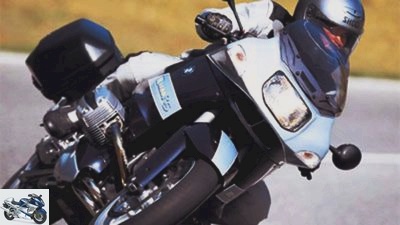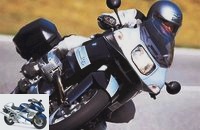Menus

Jahn
Top test BMW R 1150 RS
The trailblazer
With the R 1100 RS, BMW opened the era of the four-valve boxer in 1993. After all these years, a complete overhaul was due, which is now presented in the form of the R 1150 RS.
Words like “sensational, unique” or “ultimate” were wisely avoided when presenting the new RS. Much more was spoken of tradition, model constancy and predictable model politics. A bike for the still numerous fans of the sports tourer who obediently bought the slightly graying boxer from the dealers’ showrooms every year. Not in intoxicating numbers, but often enough that a renewal in the style of the RT models was considered worthwhile by the BMW market strategists.
The RS is now also powered by the 1150 engine already known from the RT. Six-speed gearbox, the so-called Evo brake and better wind protection are also included as standard, ABS costs extra. Only slightly modified on the chassis side, the wheels are the only apparently new thing.
At the presentation, the BMW executives decided to certify that the boxer, once advertised as sporty, was more of a touring character. Although he can still do a little sport today – a little, mind you. But who would seriously consider asking the RS to do something like that? It is true that interested passers-by or curious gas station staff surprisingly often attest to a dynamic appearance, especially in the two-tone paintwork, but the technical properties clearly point in the direction of travel.
The determination of the MOTORRAD test machine is even clearer. It is ready with all the extras, a semi-integral ABS system, heated grips and a case system. The two-tone paintwork already mentioned is also subject to a surcharge. While heated grips and painting only affect the wallet, the same applies to driving behavior with ABS. Therefore, the test machine equipped with the optionally available ABS and composite system collects the maximum possible 30 points. The point gain is offset by the poor price-performance ratio, since the surcharge (in this case 1995 marks) is taken into account.
No matter what point, the BMW brakes play a decisive role in driving. The performance of the system is impressively good. This has already been shown in the large comparison of BMW brakes (MOTORRAD 10/2001), in which the Evo brakes without ABS and integral system received the best reviews. The semi-integral system with brake booster and ABS is definitely a safety gain, but it also has certain disadvantages. Regardless of whether the ignition key is turned, waited for green at the traffic light or decelerated while driving, this brake always dominates the scene. Be it through the loud buzzing sound of the servo pump of the brake booster or through the metering that takes a lot of getting used to. The transition between the fine application of the brake pads with a slight adaptive braking – which is always necessary in flowing traffic – and the really biting grip with only slightly increased hand strength can only be felt with the utmost concentration even after around 3000 test kilometers.
It is just as difficult to tell the difference between the old 1100 and the slightly increased displacement 1150. In terms of pulling power and acceleration, the new one is only a few tenths ahead. It is gratifying that the RS now has a very clean and quiet six-speed transmission, but the gradation unfortunately leaves something to be desired. The overdrive shown in the digital gear display as E-gear lowers the speed level somewhat, but robs the RS of the last bit of liveliness that the 254 kilograms (with a full tank) left over. The fifth, on the other hand, is somewhat short. Not measured in terms of absolute speed, but – and this is much more important with this boxer – in terms of the amount of vibration.
In this regard, the new RS shows its worst side. Regardless of whether it is two, three or six thousand tours, vibrations can always be felt. As soon as the throttle is open over 20 percent, the engine runs rougher due to the higher combustion pressures, and the vibrations become annoying. Because unlike the sister models R 1150 GS and R 1150 R, there is significantly more rider weight on the handlebars, which leads to painful palms on longer stages.
The problem does not seem entirely unknown in Munich. How else can you explain that the handlebar is still mounted in four thick rubber blocks. However, this emergency solution to reduce vibrations has a decisive disadvantage: the very flexible connection between the handlebars and fork means that aiming accuracy and the precise steering feel suffer. Especially when high steering forces are required, the RS looks indirect and spongy. Fast motorway curves or jagged lane changes at high speed are just as much problematic as the quick changes of direction on the MOTORRAD handling route, where course changes have to be initiated less by shifting weight than by pulling on the handlebars.
How much potential there is in the idiosyncratic BMW chassis concept is shown not least in the astonishingly fast times achieved on the handling course. The lean angle is great, little noticeable of the heavy weight between the pylons. Only the adhesion of the Metzeler-ME Z4 tires sets limits in the high summer temperatures.
The last bit of grip does not play a decisive role on the country road. If you let the BMW do its thing and surf comfortably across the country, then it shows its pleasant side. Well balanced, it reacts pleasantly agile and track-loyal. After a brief steering impulse, it tilts very neutrally so that – always with pulling on the rear wheel – it can be negotiated undeterred by bumps or patches. Which is due to the comfortably designed coordination of the spring elements. They swallow almost all unevenness, only short, hard heels, for example on manhole covers or when frost breaks out, neither the Tele nor the Paraleversystem likes. Every time there is a hard blow through the framework. The explanation of the MOTORRAD technicians: The unsprung masses are high, in front the long sliding tubes, the swing arm with steering bearing and strut, in the back the powerful cardan swing arm with the bevel gear drive. The new, lighter five-spoke wheels only look like a drop in the ocean.
The new model deserves great praise in terms of consumption. Although you have to pick up the expensive super at the gas station, these mandatory visits can be postponed for a long time. After all, a full tank of fuel is enough for 500 kilometers on a comm or country road trip. Provided you don’t rely on the digital fuel gauge. This shows in a very moody way, varies uphill or downhill by two or three bars and sounds an alarm via the reserve lamp if fuel spills in the tank for exactly 121 kilometers. In addition, the same holds for the test motorcycle just under a liter more than the specified 23 liters.
B.First of all, it is also about the windbreak. The windshield grew by eight centimeters in height and six in width. With the appropriate setting, even drivers up to 190 centimeters can now find a quiet, almost turbulence-free spot. However, the adjustment mechanism of the disc with the coarse rotary knob in the cockpit looks like a relic from early motorcycle days. An R 1150 RT with electrical adjustment can do that by a class better. The three-stage height-adjustable bench is still a real plus, although it takes some fiddling to thread the handlebars correctly. The well-known BMW case system is completely without blame, here the operation is correct and the price of 843 marks, which almost looks like a special offer compared with the Yamaha system for the FJR 1300 (1390 marks). Tradition also has its good sides.
Buy complete article

Top test BMW R 1150 RS
The trailblazer
Conclusion
The increase in displacement evaporates in the unfavorable gear ratio, the partially integral ABS is difficult to dose, and the vibrations are annoying. The fact that the wind protection is better, the consumption is low and the equipment is still fully tourable is relatively little progress for eight long years. It’s a good thing that the price of the basic version has also stayed almost at the old level.
Related articles
-
Artistic top test BMW R 1200 R double whopper Classic, but modern. Cruise casually or alternatively drive sportily? in the new BMW R 1200 R …
-
Triumph Trophy SE in the top test
j.kuenstle.de 20 pictures j.kuenstle.de 1/20 Wuchtbrumme: no wonder that the windbreak behind the mighty plastic facade is almost perfect ….
-
BMW R nineT and BMW R nineT Scrambler in a comparison test
www.bilski-fotografie.de 16 pictures www.bilski-fotografie.de 1/16 In the course, the nineT sisters had to prove their chassis qualities and steering precision ….
-
Top test Triumph Sprint ST ABS
Jahn Top-Test Triumph Sprint ST ABS The punk goes from Punk-Rock: That means fast rhythms, rough voices and simple compositions with three chords …
-
Endurance test interim results for the Kawasaki ZZR 1400
Gargolov long-term test interim balance sheet Kawasaki ZZR 1400 Power-Touring How does the most powerful production motorcycle manage the balancing act between traveling and racing, how …
-
Comparison test of the Suzuki family
Gargolov comparison test of the Suzuki family Family affairs A shop window, four tempting sisters and around 7,000 euros in your pocket. A story in four …
-
Comparison test between Kawasaki ZX-9R and Suzuki TL 1000 R
Comparison test between Kawasaki ZX-9R and Suzuki TL 1000 R How to take it? Finally: the Suzuki TL 1000 R wants to make V-twin fascination affordable. Two-…
-
Endurance test final balance of the KTM 125 Duke
Bilski 28 images Bilksi 1/28 So technically up to date and also cool to look at, the little one blossomed into a bestseller ad hoc. But what falls …
-
Siemer long-term test BMW R 1150 R in rapid succession She gave a brief and rarely controversial guest performance: In just under 15 months, the BMW …
-
Archive pictures KTM 640 LC4 Supermoto and the test from MOTORRAD 24-2002
markus-jahn.com 14th photos markus-jahn.com 1/14 KTM 640 LC4 Supermoto. markus-jahn.com 2/14 KTM 640 LC4 Supermoto. markus-jahn.com 3/14 KTM 640 LC4…